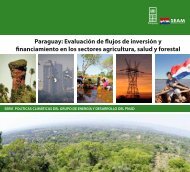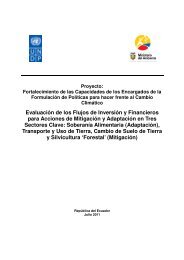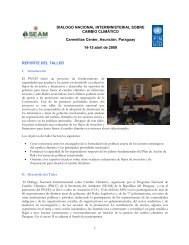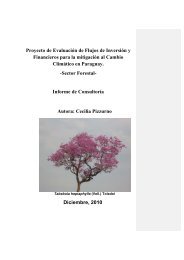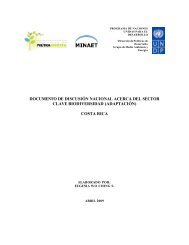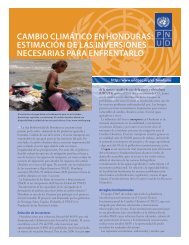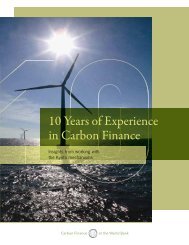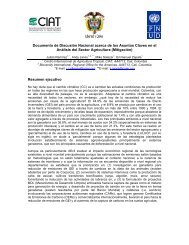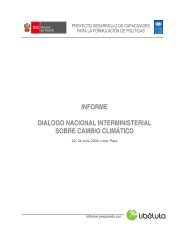national climate change awareness-raising workshop - UNDPCC.org
national climate change awareness-raising workshop - UNDPCC.org
national climate change awareness-raising workshop - UNDPCC.org
You also want an ePaper? Increase the reach of your titles
YUMPU automatically turns print PDFs into web optimized ePapers that Google loves.
Namibian National Report on Land Use, Land Use Change and Forestry (LULUCF)–Adaptation<br />
Presentation by Dr. Juliane Zeidler, Integrated Environmental Consultants Namibia (IECN)<br />
Activities in the land use sector will play a central role in Namibia’s adaptation to <strong>climate</strong> <strong>change</strong>. The term<br />
“LULUCF” comes from the UNFCCC and the Kyoto Protocol and includes six broad categories. Namibia,<br />
on the other hand, approaches the issue of land use in a more integrated manner that addresses all key<br />
production systems: (1) agriculture, including crops and livestock, (2) forestry, (3) fisheries (inland), (4)<br />
tourism, (5) wildlife and (6) the underlying ecosystem services. Degradation issues are critical, as the expected<br />
impacts of <strong>climate</strong> <strong>change</strong> will exacerbate already pressing environmental problems. Namibia is the most arid<br />
country in sub-Saharan Africa and already deals with climatic extremes. Some autonomous adaptation<br />
measures, such as conversion from livestock to wildlife-based farming, are already occurring. Some of the<br />
required measures for strengthening adaptation include: ensuring access to high-quality information about the<br />
impacts of <strong>climate</strong> <strong>change</strong> and carrying out vulnerability assessments; increasing the resilience of livelihoods<br />
and infrastructure using existing knowledge and coping strategies; and improving governance, including a<br />
transparent and accountable policy and decision-making process and an active civil society. Conducting an<br />
assessment of investment and financial flows for adaptation will require some key information, including:<br />
reliable information on expected impacts; the costs and benefits of action vs. inaction to make a good<br />
business case; key adaptation options to be strategized and costed; identification of opportunity cost of<br />
upgrading and <strong>climate</strong>-proofing existing investments, policies and project interventions; and information on<br />
current investments and financial in order to form a baseline.<br />
Working Group Discussion on Land Use–Adaptation<br />
What are future actions and key considerations at the <strong>national</strong> level for adaptation in the land-use sector (in terms of prioritising<br />
sectors/planning/policy development/opportunities)<br />
• Land-use zoning and integrated ecosystem management planning is critical: government is currently<br />
developing a land-use zoning strategy–but is there sufficient coordination between Ministries<br />
Government should make land available for resettlement for those currently living on marginal lands.<br />
• Promotion of indigenous land-use systems and diversification of farming are needed. In Namibia,<br />
only 10% of land is suited to intensive agriculture and many crops grown are not indigenous. Are the<br />
crops grown here are the best option for Namibia, while also addressing the issue of markets Are<br />
the crops are cost-effective in context of water<br />
• New management schemes are needed for livestock management. Owners do not <strong>change</strong> when the<br />
<strong>climate</strong> does. They still keep really large farms and herds even when the weather <strong>change</strong>s.<br />
• Reforestation with indigenous species.<br />
• Agro-tourism. Government policies that support this approach and provide ownership are needed.<br />
What are the major barriers in Namibia for implementing land use adaptation options<br />
• Capacity<br />
• Land tenure issues. People need ownership rather than communal land to create a motivational effect<br />
and the benefits of adaptation. They can also diversify rather than focusing on livestock, or remove<br />
fences to encourage migration.<br />
11




